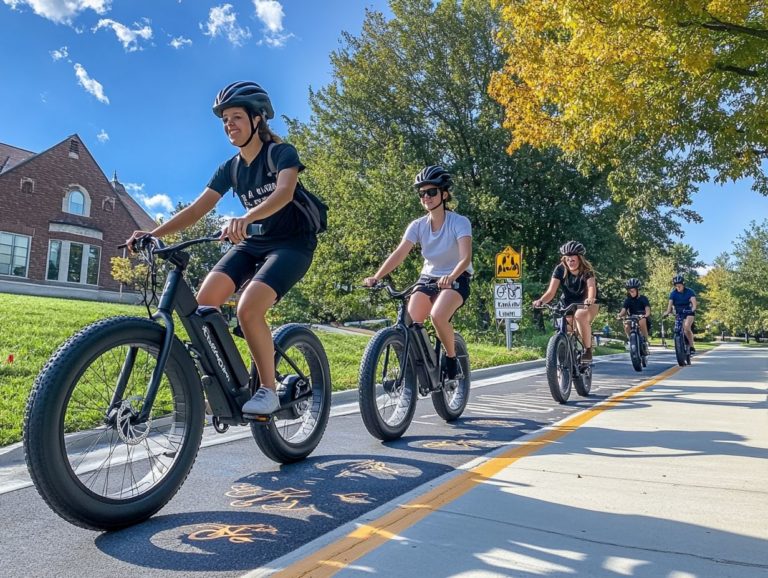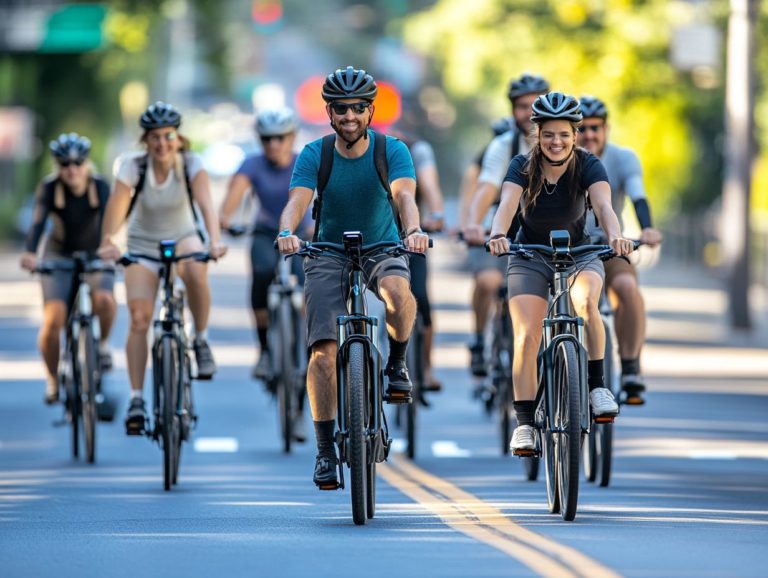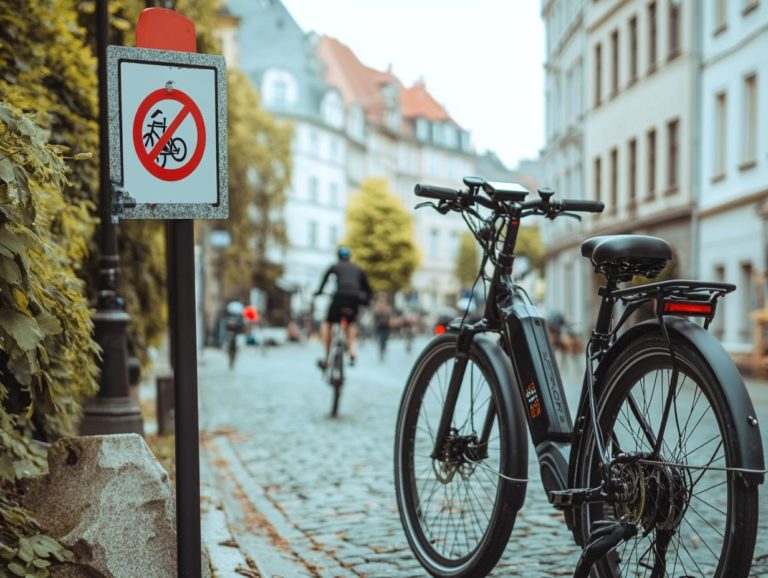Essential Electric Bicycle Equipment to Comply with Laws
As electric bicycles, or e-bikes, soar in popularity, understanding the crucial laws and regulations that govern their use becomes essential for every rider.
This article explains the essential equipment and safety features you need for compliance with California e-bike regulations. We cover everything from headlights and taillights to GPS tracking devices.
You ll discover the implications of overlooking these e-bike laws, how to ensure you meet all necessary requirements, and additional safety measures you can adopt.
Embrace the advantages of compliance with e-bike safety measures and ride with confidence!
Contents
- Key Takeaways:
- 1. Headlights and Taillights
- 2. Reflectors
- 3. Horn or Bell
- 4. Brakes
- 5. Mirrors
- 6. Electric Assist Limit
- 7. Maximum Speed Limit
- 8. Weight Limit
- 9. Age Limit
- 10. Helmet
- 11. Registration and Insurance
- 12. Turn Signals
- 13. Rear View Camera
- 14. GPS Tracking Device
- 15. Safety Flag
- What Are the Laws and Regulations for Electric Bicycles?
- Frequently Asked Questions
- What is considered essential electric bicycle equipment to comply with laws?
- Do I need to wear a helmet when riding an electric bicycle?
- Are there restrictions on the maximum speed of electric bicycles?
- Do I need a license to ride an electric bicycle?
- What other equipment should I consider for safety when riding an electric bicycle?
- Can I modify my electric bicycle to go faster than the legal limit?
Key Takeaways:
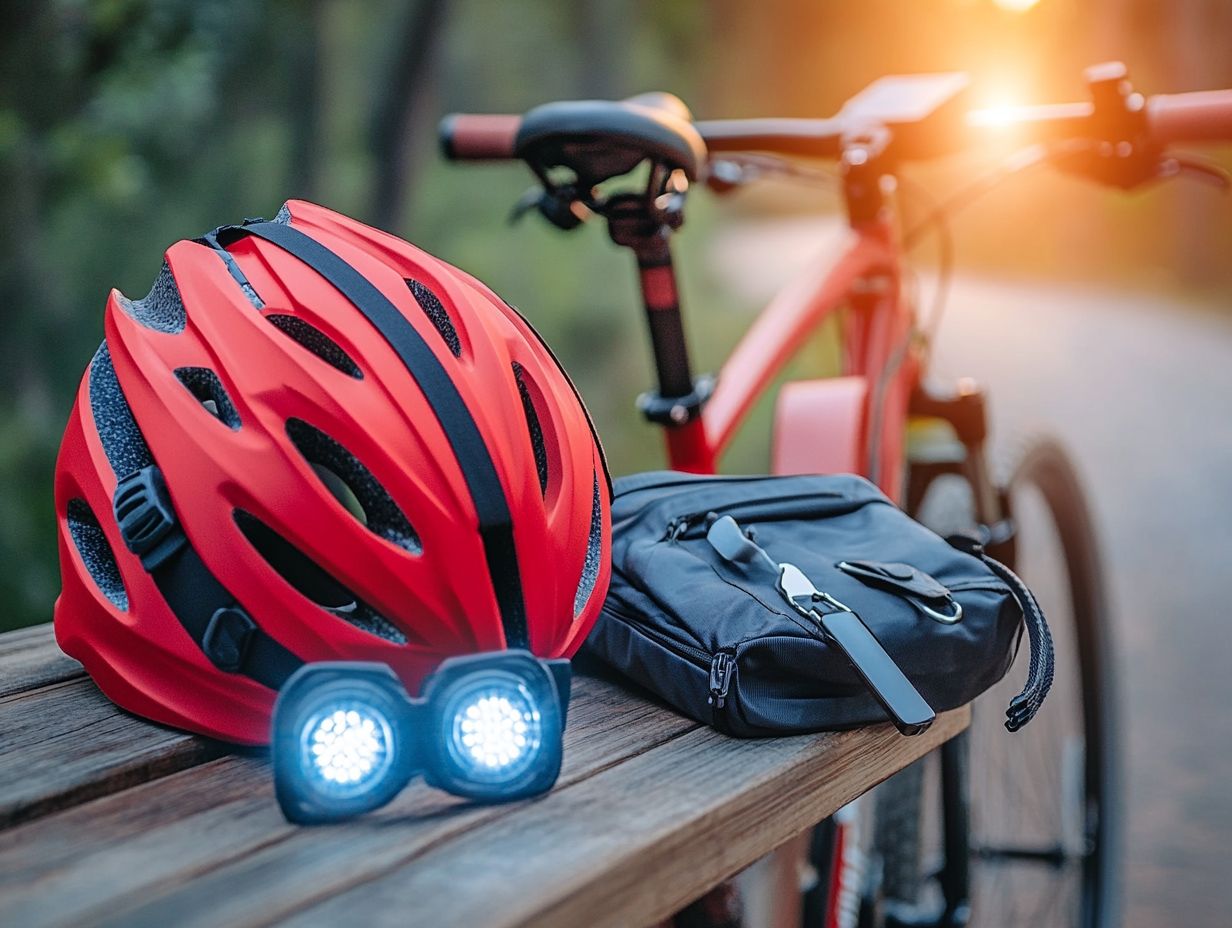
- Ensure your e-bike is equipped with headlights, taillights, reflectors, and a horn or bell to comply with laws.
- Adhere to electric assist, maximum speed limits, weight, and age limits as per state regulations to avoid facing consequences for non-compliance.
- Consider additional safety measures such as turn signals, rear view cameras, GPS tracking devices, and safety flags for added protection and to comply with laws.
1. Headlights and Taillights
Proper illumination is essential for your e-bike. Equipping it with reliable headlights and taillights significantly enhances your safety and visibility, especially when navigating bustling urban environments like California or New York City. Here, e-bike usage is on the rise and regulations are firmly in place.
In these areas, both California and New York City enforce strict lighting regulations. All e-bikes must have functional lights for safer nighttime riding. You ll find a variety of lighting options available, from basic LED models to rechargeable designs that offer superior brightness. Each ensures you remain visible in changing weather conditions, whether it s rain or fog.
Bright headlights will illuminate dark pathways and alert fellow road users, while taillights keep you visible from behind. This ensures compliance with local e-bike regulations. By adhering to these e-bike laws, you not only contribute to safer cycling practices but also promote greater awareness among all road users, effectively reducing the risk of accidents.
2. Reflectors
Reflectors are essential accessories for your e-bike. They significantly boost your visibility during low-light conditions and ensure you adhere to e-bike safety regulations in states like California and New York City.
These reflectors come in various forms think spoke reflectors, rear triangle stickers, and handlebar reflectors each carefully positioned to optimize their effectiveness. Crafted from high-visibility materials like retroreflective fabric (which reflects light back to its source) or plastic, they adeptly bounce light from headlights, making your e-bike conspicuous on dimly lit roads.
Positioning them correctly not only helps you maintain a safe profile at night but also aligns with local laws designed to protect cyclists and enhance public awareness on the streets. By incorporating these reflectors into your ride, you actively contribute to your safety and that of everyone sharing the road with you.
3. Horn or Bell
Equipping your e-bike with a horn or bell is a crucial safety measure. It allows you to alert pedestrians and fellow cyclists, significantly enhancing public safety in bustling locales like California and New York City.
These devices are crucial for safety. They serve a vital role in promoting safer road usage and ensuring compliance with local regulations that frequently require such features. You have many options, from traditional bells that emit a charming chime to more robust electric horns that slice through the urban cacophony and grab attention in a flash.
Effective choices typically include compact, lightweight options that can be easily mounted to your handlebars, ensuring quick accessibility as you navigate crowded spaces. By utilizing a horn or bell, you not only protect yourself but also foster a collective understanding of safety on the road.
4. Brakes
Reliable braking systems are essential for your safe operation of e-bikes. They protect you as a rider and ensure compliance with Consumer Product Safety Commission standards and various state regulations across the United States.
These systems can take many forms, including disc brakes, drum brakes, and hydraulic brakes. Each offers distinct advantages tailored to your riding conditions and personal preferences. Regular maintenance of your braking system is vital; it helps ensure optimal performance and adherence to safety standards.
Familiarize yourself with state-specific regulations that outline performance benchmarks, such as stopping distances and responsiveness.
By keeping up with these guidelines, you not only enhance your safety but also boost your confidence as you navigate diverse terrains and urban landscapes.
5. Mirrors
Mirrors significantly enhance your situational awareness as an e-bike rider. They enable you to monitor your surroundings effectively, which is particularly crucial in bustling areas like California and New York City, where traffic can be intense.
These reflective accessories come in a range of styles, from handlebar-mounted options to helmet-integrated models. Each is designed to help you quickly spot vehicles, pedestrians, and potential hazards while complying with helmet laws.
Proper placement of these mirrors is essential. They need to be positioned to give you an unobstructed view of the road and the traffic behind. This smart setup helps you change lanes safely and confidently.
By being more attuned to your environment, you ll find it easier to comply with local e-bike laws. Ultimately, mirrors are invaluable for minimizing accidents and fostering responsible riding behavior.
6. Electric Assist Limit
Understanding the electric assist limit is crucial for anyone navigating the world of e-bikes. This knowledge helps you differentiate between the various classes Class 1, Class 2, and Class 3. Each has its own set of regulations concerning pedal-assist functionality.
Class 1 e-bikes provide assistance only while you’re pedaling, with a speed cap of 20 mph. They are perfect for those who appreciate a more traditional cycling experience while adhering to specific legal guidelines.
Class 2 models come with a throttle, allowing you to glide along at speeds up to 20 mph without needing to pedal. They are ideal for those who prefer a more laid-back ride.
If you’re looking to cover greater distances quickly, Class 3 e-bikes assist up to 28 mph while pedaling.
These classifications are important for knowing where you can ride legally and what safety measures might be necessary. By understanding these distinctions, you ensure that you’re fully aware of your responsibilities on the road, making for a safer and more enjoyable riding experience.
7. Maximum Speed Limit

Maximum speed limits for e-bikes are crucial for ensuring your safety and that of pedestrians, with laws varying widely across states. For instance:
- California: E-bikes are divided into three classes, each with its own speed limits.
- Class 1: Up to 20 mph without a throttle.
- Class 2: Up to 20 mph with a throttle.
- Class 3: Up to 28 mph while pedaling.
- New York: E-bikes can travel up to 25 mph, which enhances accessibility in urban environments.
These variations in maximum speed limits and classifications are designed to protect you as a rider while improving overall public safety. By adhering to state-specific regulations, you contribute to a culture of responsible riding and ensure you re aware of the limits while enjoying your chosen mode of transportation.
8. Weight Limit
Establishing a weight limit for e-bikes is essential for ensuring both safety and performance. Exceeding these weight limits can compromise handling, braking, and overall rider safety, following the guidelines set by the Consumer Product Safety Commission and various e-bike safety regulations.
Ignoring these weight limits puts your safety and that of others sharing the road at risk. Excessive weight can lead to reduced battery life, diminishing your e-bike’s efficiency and performance.
Failing to comply with these regulations might void your warranty or lead to penalties, adding financial consequences to the existing dangers.
Ignoring these limits can lead to serious consequences, including dangerous riding conditions! The implications of disregarding these limits range from increased stopping distances to a heightened risk of mechanical failures. Pay attention to the weight limits to ride safely and enjoy your e-bike fully!
9. Age Limit
Age limits for operating e-bikes are set to promote your safety and ensure responsible usage while complying with specific laws that vary by state. For instance, California and New York have regulations governing e-bike accessibility.
In California, you must be at least 14 years old to ride an e-bike, while New York requires riders to be 16 or older. These age-specific rules ensure that younger individuals possess the maturity and physical capability needed to navigate road complexities.
By imposing these age limits, lawmakers aim to minimize accidents and enhance road safety. They encourage you to develop responsible riding habits from a young age, educating younger riders about safe practices and fostering a culture of respect for traffic laws and shared road space.
10. Helmet
Wearing a helmet is critical to protect yourself in case of accidents and is mandated in states like California and New York City, aimed at reducing injury severity.
In California, all riders under 18 must wear a properly fitted and fastened helmet while riding an e-bike. This law safeguards younger individuals, who may be more susceptible to accidents. New York City shares this philosophy, emphasizing helmet use for riders of all ages navigating its bustling streets.
Various helmets are available, including those specifically designed for urban commuting and others that adhere to strict safety standards set by organizations like the Consumer Product Safety Commission (CPSC). Helmets absorb impact during collisions, significantly lowering the risk of traumatic brain injuries. They can also enhance your overall riding experience with features like integrated lights or visors.
Ultimately, embracing helmet usage is a straightforward yet vital step to foster safer riding experiences on your e-bike.
11. Registration and Insurance
You need to register and insure your e-bike. This is important for following the law and protecting yourself, aligning with state regulations in places like California and New York City.
These requirements help you understand your responsibilities as a rider while enhancing overall safety on the roads. In California, for example, you’ll need to register your e-bike, which means providing proof of purchase and adhering to specific guidelines about speed limits and motor size (the power of your e-bike’s motor). Likewise, New York City requires e-bike users to secure insurance, protecting both you and others in the event of an accident. Additionally, it’s beneficial to have the right tools; check out this list of essential tools every electric bicycle owner should have for maintenance and repairs.
By fulfilling these obligations, you help foster a more responsible and secure environment, effectively reducing potential liability issues that may arise from accidents or negligence.
12. Turn Signals
Incorporating turn signals on your e-bike significantly enhances communication with other road users, elevating both safety and compliance with e-bike laws.
When navigating crowded urban landscapes, the effectiveness of various turn signals whether mechanical, electric, or hand signals is essential. These signals act as vital indicators of your intent, enabling drivers, cyclists, and pedestrians to anticipate your next move.
By adhering to local regulations regarding turn signaling, you contribute to a safer environment and reinforce your responsibility to comply with traffic laws. This mindful approach to signaling etiquette fosters a sense of community among all road users.
13. Rear View Camera
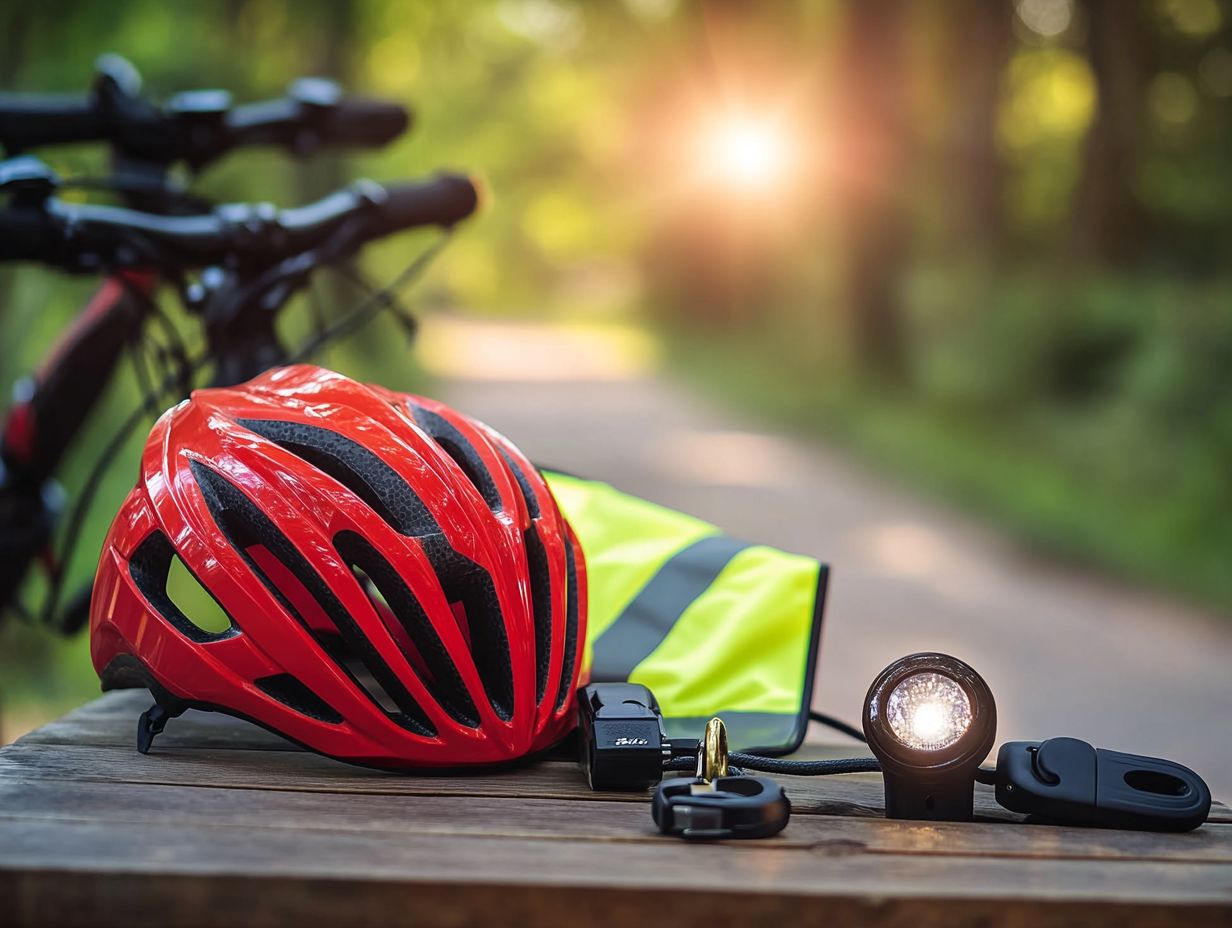
Utilizing a rear view camera on your e-bike can significantly enhance your awareness and safety. These cameras offer critical visual feedback, allowing you to keep an eye on your surroundings without twisting your head.
Improved situational awareness is especially beneficial when navigating crowded streets or executing quick maneuvers around obstacles. As e-bikes rise in popularity, some jurisdictions may require these safety devices.
Stay informed about local laws and best practices for safe riding to contribute to a more secure environment for everyone on the road!
14. GPS Tracking Device

Installing a GPS tracking device on your e-bike enhances your safety and security. These devices provide real-time location tracking, allowing you to monitor your e-bike s whereabouts.
They also send immediate alerts in emergencies, whether it s an accident or attempted theft. Many models feature a virtual boundary for your bike, notifying you if it strays beyond a designated area.
Stay informed about local regulations regarding the use of GPS devices to ensure these safety enhancements respect your rights while keeping you safe on the road!
15. Safety Flag
Installing a safety flag on your e-bike significantly boosts your visibility. Choose from vibrant streamers or reflective banners that demand attention!
Proper placement is key; mount the flag high enough to maximize visibility without blocking your line of sight. By adding a safety flag, you elevate your own awareness on the road.
This contributes to a culture of safety that aligns with local regulations, particularly as cities adapt to the increasing presence of e-bikes!
What Are the Laws and Regulations for Electric Bicycles?
The legal landscape for e-bikes varies widely by state. In California and New York, specific laws cover everything from registration to speed limits and safety requirements.
California categorizes e-bikes into three types: Class 1, Class 2, and Class 3. Each class has its own rules about where you can ride and how fast.
If you’re a Class 3 rider, helmet laws are stricter, so pay attention to those regulations.
New York’s laws are changing rapidly to match the growing popularity of electric bicycles. Local rules about licensing and registration can vary, making it tricky to keep up.
Understanding these rules is vital for your own safety and to avoid legal issues. Stay informed so you can ride without stress and help create a safer road environment.
What Are the Consequences of Not Complying with These Laws?
If you don’t follow e-bike laws, you could face serious consequences, including fines or being held liable for accidents.
For example, ignoring speed limits or riding in restricted areas can lead to hefty fines. This could cost you hundreds of dollars and put you at risk of lawsuits.
Consider a cyclist who rode an e-bike on a pedestrian-only path; they faced significant legal issues, including a major settlement.
Such instances highlight how crucial it is to understand and follow local regulations. Not complying can hurt community safety and the public’s view of e-bikes.
How Can One Ensure They Are Meeting All Requirements?
To comply with e-bike laws, you need to know the specific rules in your state. This includes understanding the types of e-bikes, safety requirements, and registration processes.
Start by researching local regulations, as they differ between cities. Consult state and local authorities to clarify what permits you need and any restrictions.
Stay updated on legislative changes, as e-bike laws are changing quickly. You can join e-bike organizations or online forums to share updates and get advice.
By following safety standards like wearing helmets and knowing traffic rules, you promote responsible riding and help everyone enjoy the experience.
Are There Any Safety Measures That Can Be Taken?
You can take extra safety measures beyond the basic gear required by law. These actions enhance your protection and the safety of others on the road.
Using visibility gear, such as reflective vests and bright helmets, helps others see you better, especially in low light.
Wearing reflective clothing is also smart; it makes you more visible from a distance.
Practice safe riding habits: use hand signals, keep a safe distance from vehicles, and avoid distractions.
All these measures not only boost your safety but also promote responsibility among all road users, helping to reduce accidents.
What Are the Benefits of Complying with Electric Bicycle Laws?
Complying with electric bicycle laws offers many benefits. These include better safety for everyone, lower risk of accidents, and a positive view of e-bikes in your community.
When you follow these rules, you protect yourself and others. You also help create a safer environment for pedestrians and cyclists.
This responsibility fosters acceptance of e-bikes, making it easier for them to be part of local transport. Following the law builds respect between e-bike users and other road users, which reduces conflicts.
Staying informed about e-bike laws helps you avoid potential legal problems. This way, you can enjoy your e-bike without worrying about fines or penalties.
Frequently Asked Questions
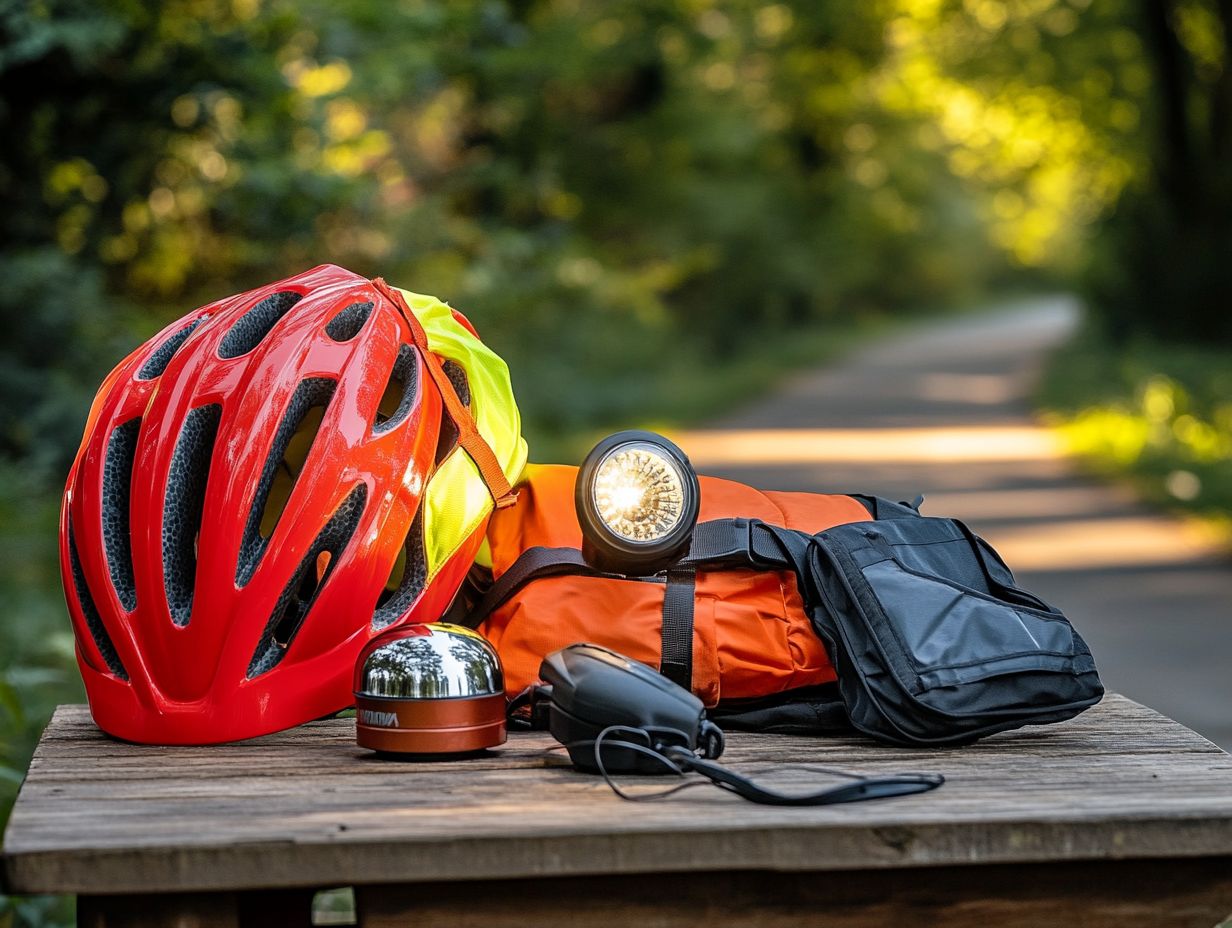
What is considered essential electric bicycle equipment to comply with laws?
Essential equipment includes a working headlight, taillight, and reflectors on the front, back, and sides.
Do I need to wear a helmet when riding an electric bicycle?
Most states don’t require helmets, but it’s always best to wear one for safety.
Are there restrictions on the maximum speed of electric bicycles?
Yes, most states limit e-bike speeds to between 20 and 28 miles per hour.
Do I need a license to ride an electric bicycle?
A license is usually not required if your e-bike meets specific speed and power limits. Always check local laws to be sure.
What other equipment should I consider for safety when riding an electric bicycle?
Wear bright, reflective clothing and use hand signals in addition to the required lights and reflectors.
Can I modify my electric bicycle to go faster than the legal limit?
Modifying your e-bike to exceed legal limits is not advised and could get you in trouble. Always follow your state’s regulations.

